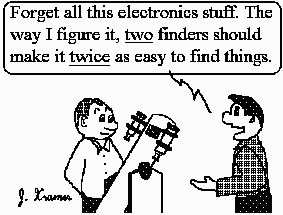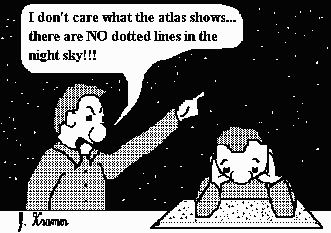So How Do You Find Things Without Computer Assistance?
Jack Kramer
Just Once wouldn't it be nice to locate a faint object by aiming your scope at the sky, then seeing it right there in your eyepiece? Despite the availability of electronic aids, finding our way around by star-hopping is the way most of us begin. The majority of deep sky objects are faint, but with experience and a few tricks, locating them can become an enjoyable pursuit rather than a source of frustration. Here are some tips.
Know the sky. Experienced observers invariably spend a short time just gazing up at the night sky when they get to their observing sites. This helps you become familiar with the orientation of the constellations, especially if you haven't been out observing for awhile. It also gives your eyes a chance to become dark-adapted before you begin any serious observing. And if it's a really dark sky, it's nice to just absorb the beauty for awhile.

Use a good finder. This seems pretty obvious, since most telescopes are equipped with some sort of finder. But there are finders and there are finders. First of all, even with very wide field copyscopes, it's helpful to have some sort of sighting gizmo so that you know where you're aiming. This can be as simple as a V-groove sight used on rifles. This "zero power" sight has been taken a step further with the Telrad illuminated device. Having used these a number of times, I can attest that they're handy for getting to the general area where you want to go. If they're properly aligned with the telescope, you can aim at a bright object and it'll be in your eyepiece. But these aren't much good where you have to follow a pattern of stars to get where you're going. With the Telrad you're looking through a piece of glass on which is projected the reticle pattern, so some faint objects that are visible in the sky disappear when looking through the Telrad. To do real star hopping you need a bright, magnified view. Finder telescopes are identified by their magnification and diameter of objective lens. An 8x50 finder magnifies the image eight times and has an objective lens of 50mm diameter. A 6x30 is the bare minimum that'll do any good; 8x50 or larger is preferable. Normally, the larger the objective lens, the wider will be your field of view and the brighter will be the objects seen through the finder. Many cheap telescopes include tiny finders that remind you of looking through a soda straw...and they're just about as useful! Some observers make a practice of using two types of finders: a Telrad to get to the general area where they're going and an optical finder to star-hop the rest of the way. Finally, I have never been able to use finders that have right-angle adapters, because they reverse the image right-to-left. A straight-through finder may be more awkward to look through at times, but it shows you things as you see them normally, and for me that makes it easier to use.
The darker the sky, the better. Obviously, faint objects are easier to see in a dark sky. But if there's a lot of stray light around, you can improve the situation by shielding your eyes with your hand or the brim of a hat. In the cold weather, the hood of a parka can do double duty. A rubber eyecup attached to the eyepiece is a big help. Some observers cover their heads with a dark cloth to cut out ambient light. However, another problem occurs when the sky is really dark. Then there are so many stars visible that it sometimes becomes difficult to starhop until you get over the initial confusion.

A good star atlas is a must. There should be a law that anyone who buys a first telescope must get a good star atlas. Forget about the little pocketbook-sized field guides to astronomy. They contain some very handy info, but the little sky charts included aren't nearly detailed enough to help you find anything except the very brightest objects. The Tirion Sky Atlas 2000 has become the standard for most amateur astronomers and it is as much as many people will ever need. There are several other less-detailed, large scale atlases that will also do the job. Study the atlas before your observation to plan your route, and keep it handy near your telescope. Select a few objects on which to concentrate.
Protect your night vision. The most obvious way to do this is by using a flashlight with a red lens, since red light has the least adverse effect on your ability to see in the dark. But even red light has some effect, so try keeping your observing eye closed while looking at charts, or use an eye patch to maximize night vision in one eye. Bright sunlight has the longest term ill effect, so during the day prior to the observing night, wear sunglasses until well after sunset.
Get to know the orientation in your scope. It's helpful to move your telescope a bit while looking through it in order to get the feel of how things move in your finder and in the main telescope. An even number of reflections (as in a Newtonian) turns your image upside down. An odd number of reflections (as in a Schmidt-Cassegrain) reverses the image left to right. This will give you a feel for where you're going as you move from one field to the next.
Know your field of view. We've already seen that a wide field of view in your finder is an important factor in making your search easier. But your finder doesn't generally put you right on top of a faint object. That means you'll have to complete your search through the main telescope, so it's important to know how large a field of view is presented by the eyepiece. There are several ways of doing this, but the quickest is simply to sight in on a field with several bright stars, then check your atlas to see how large a field is covered. Knowing this, you have a better feel for how far you may need to move with each sweep. And you'll be doing a lot of sweeping especially when looking for asteroids and comets, which move fairly rapidly. Once the actual field of view has been determined, some observers have found it helpful to make a cardboard template of the fields with each eyepiece keyed to the scale of the star atlas. Stores that sell drafting supplies carry clear plastic templates with various sizes of circles already cut out - more circles than you'll need. Using this with your atlas helps plan star-hopping routes.
Use a low-power, wide-field eyepiece. It follows from the above that a wide field ocular will make it much easier to sweep the area until you pick up the object of your search. After you've located the object, then switch to a higher power eyepiece, if conditions warrant. Some new telescope users create their own frustration by trying to use higher power eyepieces. However, as you gain experience, you will find that it's often possible to use higher power to locate objects, so long as the eyepiece is one of the newer designs with a very wide field of view.
Get comfortable. If possible, keep your body stable and comfortable by sitting on a chair or stool. The human body has a tendency to sway slightly as you peer through the telescope. Efforts to correct the situation only cause you to tense up and that makes it difficult to concentrate fully on the job at hand. Another trick is to fight the tendency to squint by keeping both eyes open while observing. This relaxes your eye muscles. Some observers find it helpful to use an eye patch over the idle eye to prevent conflicting visual signals from reaching the brain. A convex-shaped eye patch allows you to blink without having your eyelashes constantly brushing against the inside of the patch.
Accommodate if you wear eyeglasses. If you wear glasses, be aware of the eye relief of your eyepiece. The term "eye relief" refers to how far back from the eyepiece you need to position your eye in order to take in the entire field of view without interference from a dark spot. Some eyepiece designs have a longer eye relief, which prevents constantly hitting the ocular with your glasses. Eyepieces with shorter eye relief require you to remove your glasses to take in the entire field. However, refocusing the telescope often corrects for a number of vision defects.
Plan your moves. After all the foregoing stuff has been taken care of, the focus of this whole exercise is to find that faint object up there. It's counterproductive to just flail away at the sky with your telescope. Although success is not always assured, we learn by our mistakes; eventually, you'll seldom come up empty-handed. The first step after locating your target in the atlas is to find a star from which to begin your search. Of all the false starts I've made over the years, this has been the most frequent. It's not a matter of finding a starting point on the chart, but rather, finding that star in the sky. Let's face it, most stars look the same. There's simply no substitute for acquiring the ability to relate what you see in the atlas with what you see in the sky...and experience is the best teacher. Assuming the galaxy, nebula, comet, asteroid, or whatever is within the light grasp of your telescope, and if you simply cannot locate it, then go back and verify that you began from the correct star. You may be surprised to find how far you've roamed away from your target area. If the object isn't near a reasonably bright star, then you'll have to use a series of fainter stars as stepping stones. Look for several stars that form some sort of pattern. A relatively faint star setting out there pretty much by itself is a poor choice because you can easily head off in the wrong direction, or simply pick the wrong star in the sky. One source of confusion is that the sizes of the star images as shown on your chart may suggest that they're either brighter or fainter than they actually are; this is the result of the scale selected to portray the range of magnitudes in the atlas. As a general rule, try to get as close as possible to your object using just the stars that are visible in your finder. In some cases, you may hop from object to object, rather than from a star to an object. This particularly occurs in rich galaxy fields. And sometimes you can position the telescope on a nearby star at the same declination or right ascension as the object for which you're searching. That way, you only have to move the scope in one direction to get there.
Despite the availability of setting circles and computer-assist devices, star-hopping is the way the majority of amateur astronomers start out. Some of us stick with it for a lifetime. Amateur astronomers typically know their way around the sky much better than the professionals, who obviously can't star- hop with an observatory-sized instrument. The skill of being able to locate faint objects is something that's only acquired with practice and patience. To borrow a phrase from the real estate industry, there are three things that spell success as an observer: location, location, location!
Published in the May 1995 issue of the NightTimes




